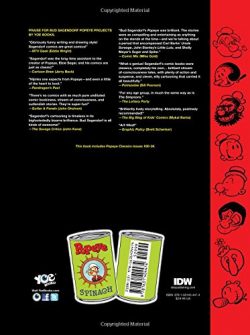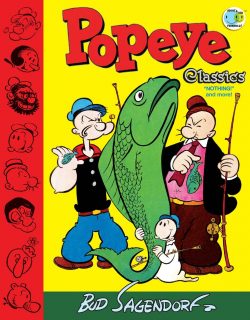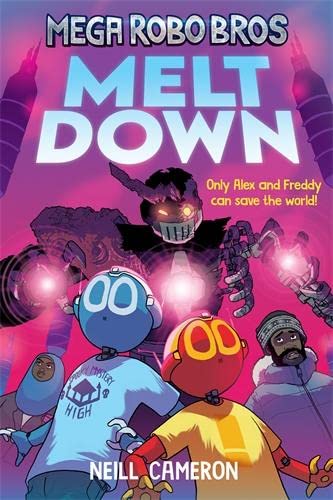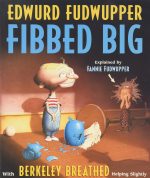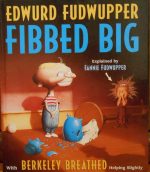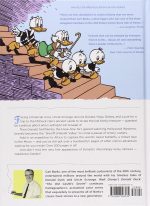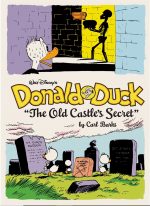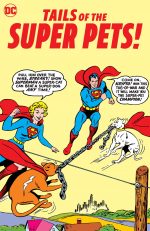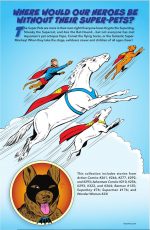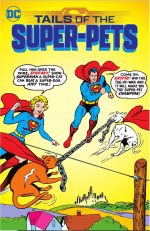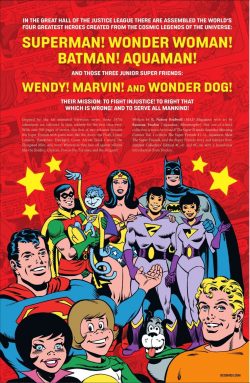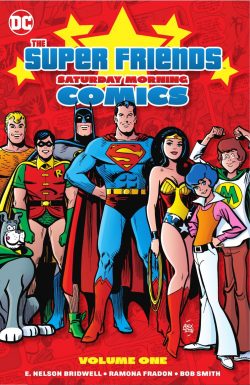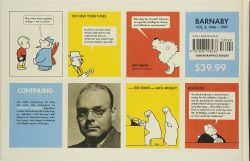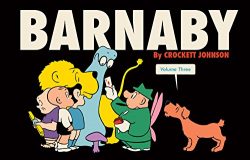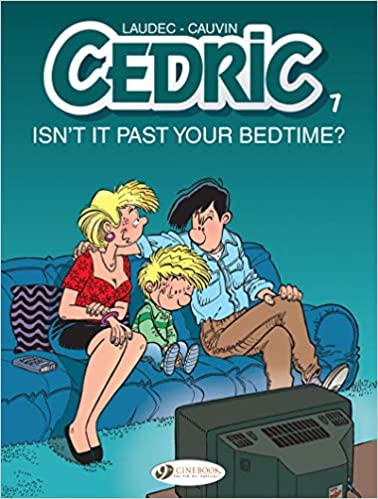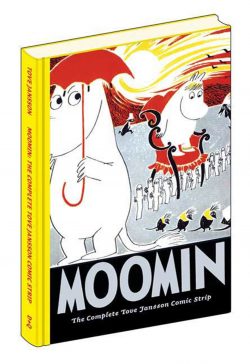
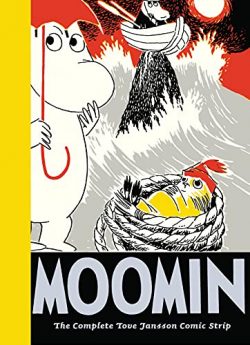
By Tove and Lars Jansson (Drawn & Quarterly)
ISBN: 978-1-897299-78-4 (HB) eISBN: 978-1-77046-551-0
If Tove Jansson was alive today she’d still be amazing and fascinating and also 108 years old. Sadly, she isn’t, but her immortal menagerie of bizarre and introspective characters are still going strong and all her best material is readily available for anyone wanting to politely, respectfully and belatedly join in all the dreamy fun…
Tove Jansson was one of the greatest literary innovators and narrative pioneers of the 20th century: equally adept at shaping words and images to create worlds of wonder. She was especially expressive with basic components like pen and ink, manipulating slim economical lines and patterns to realise sublime realms of fascination, whilst her dexterity made simple forms into incredibly expressive and potent symbols.
Tove Marika Jansson was born into an artistic, intellectual and practically bohemian Swedish family in Helsinki, Finland on August 9th 1914. Father Viktor was a sculptor, her mother Signe Hammarsten-Jansson a successful illustrator, graphic designer and commercial artist. Tove’s brothers Lars and Per Olov became a cartoonist/writer and photographer respectively. The family and its close intellectual, eccentric circle of friends seems to have been cast rather than born, with a witty play or challenging sitcom as the piece they were all destined to act in.
After intensive study from 1930-1938 (at the University College of Arts, Crafts and Design, Stockholm, the Graphic School of the Finnish Academy of Fine Arts and L’Ecole d’Adrien Holy and L’Ecole des Beaux-Arts, Paris), shebecame a successful exhibiting artist through the troubled period of the Second World War.
Intensely creative across many fields, she published the first fantastic Moomins adventure in 1945: Småtrollen och den stora översvämningen (The Little Trolls and the Great Flood or latterly and more euphoniously The Moomins and the Great Flood): a whimsical epic of gentle, inclusive, accepting, understanding, bohemian, misfit trolls and their strange friends…
A youthful over-achiever, from 1930-1953 Tove worked as an illustrator and cartoonist for the Swedish satirical magazine Garm, achieving some measure of notoriety with an infamous political sketch of Hitler in nappies that lampooned the Appeasement policies of Chamberlain and other European leaders in the build-up to World War II. She was also an in-demand illustrator for many magazines and children’s books, and had started selling comic strips as early as 1929.
Moomintroll was her signature character. Literally.
The lumpy, gently adventurous big-eyed romantic goof began life as a spindly sigil next to her name in her political works. She called him “Snork” and claimed she had designed him in a fit of pique as a child – the ugliest thing a precocious little girl could imagine – as a response to losing an argument about Immanuel Kant with her brother.
The term “Moomin” came from her maternal uncle Einar Hammarsten who attempted to stop her pilfering food when she visited, warning her that a Moomintroll guarded the kitchen, creeping up on trespassers and breathing cold air down their necks. Snork/Moomin filled out, became timidly nicer – if a little clingy and insecure – acting as a placid therapy-tool to counteract the grimness of the post-war world.
The Moomins and the Great Flood didn’t make much of an initial impact but Jansson persisted, probably as much for her own edification as any other reason, and in 1946 the second book Kometjakten (Comet in Moominland) was published. Many commentators have reckoned the terrifying tale a skilfully compelling allegory of Nuclear Armageddon.
When it and her third illustrated novel Trollkarlens hatt (1948, Finn Family Moomintroll or occasionally The Happy Moomins) were translated into English in 1952 to great acclaim, it prompted British publishing giant Associated Press to commission a newspaper strip about her seductively sweet and sensibly surreal creations.
Jansson had no misgivings or prejudices about strip cartoons and had already adapted Comet in Moominland for Swedish/Finnish paper Ny Tid. Mumintrollet och jordens undergäng – Moomintrolls and the End of the World – was a popular feature so Jansson readily accepted the chance to extend her eclectic family across the world.
In 1953, The London Evening News began the first of 21 Moomin strip sagas which promptly captivated readers of all ages. Jansson’s involvement in the cartoon feature ended in 1959, a casualty of its own success and a punishing publication schedule. So great was the strain that towards the end she recruited brother Lars to help. He took over, continuing the feature until its end in 1975. His official tenure as writer will begin in the next volume: stay tuned…
Liberated from the strip, she returned to painting, writing and other creative pursuits, generating plays, murals, public art, stage designs, costumes for dramas and ballets, a Moomin opera and 9 more Moomin-related picture-books and novels, as well as 13 books and short-story collections strictly for grown-ups.
Tove Jansson died on June 27th 2001. Her awards are too numerous to mention, but consider this: how many modern artists – let alone comics creators – get their faces on the national currency?
Her Moomin comic strips have long been available in Scandinavian volumes and the discerning folk at Drawn & Quarterly have translated her and Lars’ efforts into English for our sheer delight and delectation.
Moomintrolls are easy-going free spirits, bohemians untroubled by hidebound domestic mores and most societal pressures. Moominmama is warm and capable but overly concerned with propriety and appearances whilst Moominpappa spends most of his time trying to rekindle his adventurous youth or dreaming of fantastic journeys. Their son Moomin is a meek, dreamy boy who adores their permanent houseguest the Snorkmaiden – although that impressionable, flighty gamin prefers to play things slowly whilst waiting for somebody potentially better…
The forth oversized (312 x 222mm) monochrome hardback compilation gathers the 14-18th strip sagas and is a particular favourite, comprising a range of fanciful exploits and a rather bleak and a scary reworking of Comet in Moominland that must have had kids and their parents stocking the bomb-shelters back when it was released as a daily chapter play…
Fantasy fills the page in ‘Moomin Goes Wild West’ after Moominpapa’s annoying tinkering ruin a perfectly good clock and Moominmama’s sewing machine, whilst his attempt at repair accidentally results in a time machine. Following a distressing episode wherein Moomintroll meddles and the family meet their rather upset future selves, it is suggested that everyone go on a small holiday. The women’s rather staid suggestions are naturally overruled by the adventurous males and the machine summarily deposits them all in the land of cowboys.
It is nothing like they imagined and a very good thing that were armed with water pistols and not regulation firearms…
Sadder but no wiser after their extended tribulations in the Big Country, the assembled and not at all rested Moomins submit to suggestions of a little historical romance and travel back to 18th century France in ‘Snorkmaiden Goes Rococo’. Once again, lack of diligent research and an overdependence on popular fiction leads to misunderstanding and mischance as “the Age of Reason” proves to be anything but, and Snorkmaiden’s dreams of passionate folly are continually thwarted.
She does however score an invitation to the King’s Dinner, only to learn how badly the odds are stacked against the poor, and is promptly impelled to experiment with revolution…
Back where they all belong at last, the return of self-sufficient drop-out Snufkin heralds a visit from a representative of the League of Conscience and Duty exhorting the easy-going, but dutiful nonconformists (some unpleasant modern people say “workshy”) to dedicate their lives to personal industry and privation in service of a greater good.
‘The Conscientious Moomins’ certainly try their hardest – pursuing jobs they’re no good at, indulging in entrepreneurialism and seeking to improve character through self-help books and courses – but are just not suited to such new-fangled ideas. Ultimately, nature and good sense lead them back to their bohemian true selves just in time for one of the scariest adventures of their lives…
Comet in Moominland was first translated into English in 1951, and was a familiar text for many children and parents. Here in ‘Moomin and the Comet’ the allegory of nuclear armageddon is subtly reshaped over 86 daily instalments: modernised with the emphasis shifted from narrow escape to inescapable destruction leading to unexpected rebirth.
When a light gradually grows in the sky, the Moomins and their friends can only observe the world’s peoples’ increasing turmoil and riot. As the planet slowly alters in advance of imminent catastrophe and growing heat evaporates the oceans, spiteful Little My acts as Greek Chorus and commentator as everything makes it peace with oblivion. She’s also on hand to witness and announce the miracle that saves them all…
A parable of pride and caution closes this volume as ‘Moomin and the Golden Tail’ reveals how Moomintroll’s fear of premature baldness in this nether appendage prompts unwise exploration of remedial quackery, quasi-science and old family sorcery.
The result is a lush, luxuriant tail of gold, that makes him the world’s most fashionable person and pointless celebrity. All too soon that chic lustre fades and the sad lad is hunting ways to stop being famous and go back to his old look, negligent of how his beloved Snork maiden has reshaped herself to match his gleaming fame…
Especially excoriating are the lawyers and managers who hound him seeking to lock down the marketing rights to his golden fleece, but in the end a way is found to return him to his normal, anxious, insecure, anonymous self…
These are truly magical tales for the young laced with the devastating observation and razor-sharp mature wit which enhances and elevates only the greatest kids’ stories into classics of literature. These volumes are an international treasure and no fan of the medium – or carbon-based lifeform with even a hint of heart and soul – can afford to be without them.
© 2009, 2021 Solo/Bulls. All other material © its creators. All rights reserved.

